Stationary Gas Dynamics and Heat Transfer of Turbulent Flows in Straight Pipes at Different Turbulence Intensity
Abstract
:1. Introduction
- −
- To develop a test stand and select measuring instruments for studying the gas dynamics and heat transfer of stationary air flows in straight pipes with different cross-sections (circle, square, equilateral triangle);
- −
- to obtain test data on the instantaneous values of the local velocity and local heat transfer coefficient of a stationary air flow along the length of profiled straight pipes at different initial values of turbulence intensity;
- −
- to evaluate the influence of the initial flow turbulence on turbulence intensity and the value of the local heat transfer coefficient of the air flow along the length of a straight pipe with circular, square, and triangular cross-sections.
2. Description of the Test Facility and Methodology
3. Gas-Dynamic Characteristics of Air Flow in Profiled Channels at Different Turbulence Intensities
4. Heat Transfer Characteristics of Air Flow in Profiled Channels at Different Turbulence Intensities
- −
- In a triangular tube up to a distance of about 250 mm, heat transfer is enhanced (within 10%) compared to a round channel; further, in contrast, there is a suppression of α up to 18%, if the level of heat transfer in the triangular and round pipes is compared;
- −
- when air flows in a square pipe, the level of local heat transfer is 1–25% lower than in a round pipe for the entire channel length;
- −
- as the air flow relaxes, the differences in the levels of heat transfer in square and triangular pipes gradually level out and approach the values of the local heat transfer coefficient characteristic of a round channel.
5. Conclusions
- Dependences of the instantaneous values of the air flow’s local velocity wx and the local heat transfer coefficient αx in time are obtained for the initial turbulence intensity TI from 0.02 to 0.12 along the length of pipes with different cross-sections.
- The influence of the shape of the pipe cross-section on the gas-dynamic and heat-exchange characteristics of steady-state air flows has been established:
- −
- The intensity of turbulence TI in a square pipe is up to 40% higher than in a round channel; in a triangular channel, in contrast, it is up to 28% lower;
- −
- in a triangular pipe, up to a distance of about 250 mm, there is an increase in α within 10% compared to a round channel, which is then replaced by a decrease of up to 18%;
- −
- when air flows in a square pipe, the level of local heat transfer is up to 25% lower than in a round pipe throughout the studied range of the channel length.
- The influence of initial turbulence intensity on the thermal and mechanical characteristics of steady-state flows in pipes with various cross-sections is shown:
- −
- After the initial flow turbulence, relaxation of the flow in the square and triangular pipes occurs faster than in the round channel;
- −
- as the air flow relaxes, the differences in the heat transfer in square and triangular pipes gradually level out and approach the local heat transfer coefficient typical of a round channel;
- −
- the initial turbulence intensity leads to an increase in the averaged local heat transfer, which is typical of all studied pipe configurations and initial conditions.
- The data obtained can be useful in the design of heat exchangers, gas-air systems of heat engines, ventilation and air conditioning systems, shipbuilding, and aircraft building. For example, the configuration of gas-exchange systems and the perfection of their internal processes largely determine the specific parameters of heat engines [41].
- Future research on this topic may be related to studying the influence of the configuration of pipelines and initial gas-dynamic conditions in relation to pulsating gas flows, since many technical units operate in a cyclic mode.
Author Contributions
Funding
Data Availability Statement
Conflicts of Interest
Nomenclature
| wx | local air velocity, m/s |
| w | average flow velocity, m/s |
| αx | local heat transfer coefficient, W/(m2 · K) |
| α | average heat transfer coefficient, W/(m2 · K) |
| po | barometric pressure, kPa |
| t | temperature, °C |
| d | pipeline diameter, mm |
| l | linear dimension, mm |
| TI | turbulence intensity |
References
- Terekhov, V.I. Heat Transfer in Highly Turbulent Separated Flows: A Review. Energies 2021, 14, 1005. [Google Scholar] [CrossRef]
- Kestin, J.; Wood, R.T. The influence of turbulence on mass transfer from cylinders. J. Heat Transf. 1971, 93, 321–327. [Google Scholar] [CrossRef]
- Kestin, J.; Maeder, P.F.; Wang, H.E. Influence of turbulence on the transfer of heat from plates with and without a pressure gradient. Int. J. Heat Mass Transf. 1961, 3, 133–154. [Google Scholar] [CrossRef]
- Simonich, J.C.; Bradshaw, P. Effect of free-stream turbulence on heat transfer through a turbulent boundary layer. J. Heat Transf. 1978, 100, 671–677. [Google Scholar] [CrossRef]
- MacMullin, R.; Elrod, W.; Rivir, R. Effects of free stream turbulence from a circular wall jet on a flat plate heat transfer and boundary layer flow. Am. Soc. Mech. Eng. 1988, 11521. [Google Scholar]
- MacMullin, R.; Elrod, W.; Rivir, R. Free-stream turbulence from a circular wall jet on a flat plate heat transfer and boundary layer flow. J. Turbomach. 1989, 111, 78–86. [Google Scholar] [CrossRef]
- Moffat, R.J.; Maciejewski, P.K. Effects of very high turbulence on convective heat transfer. NASA Conf. Publ. 1984, 381–388. [Google Scholar]
- Maciejewski, P.K.; Moffat, R.J. Heat transfer with very high free-stream turbulence: Part II—Analysis of results. J. Heat Transf. 1992, 114, 834–839. [Google Scholar] [CrossRef]
- Slanciauskaus, A.; Pedesius, A. Effect of Free-stream Turbulence on the Heat Transfer in the Turbulent Boundary Layer. In Proceedings of the International Heat Transfer Conference, Toronto, ON, Canada, 7–11 August 1978. [Google Scholar]
- Smylsky, Y.I.; Terekhov, V.I.; Yarygina, N.I. Heat transfer in turbulent separated flow behind a rib on the surface of square channel at different orientation angles relative to flow direction. Int. J. Heat Mass Transf. 2012, 55, 726–733. [Google Scholar] [CrossRef]
- D’yachenko, A.Y.; Terekhov, V.I.; Yarygina, N.I. Vortex formation and heat transfer in turbulent flow past a transverse cavity with inclined frontal and rear walls. Int. J. Heat Mass Transf. 2008, 51, 3275–3286. [Google Scholar] [CrossRef]
- Wang, S.; Xiao, G.; Wang, W.; Mi, H. Study of the process of deflagration flame behavior in disturbance conditions. Exp. Therm. Fluid Sci. 2022, 139, 110710. [Google Scholar] [CrossRef]
- Chang, L.; Rangwala, A.S. Experimental study of crude oil slick burning on a turbulent water surface. Combust. Flame 2022, 241, 112119. [Google Scholar] [CrossRef]
- Yen, S.-C.; Ye, C.-E.; San, K.-C. Effects of starlike control discs on flow structures and combustion capability. Energy 2021, 225, 120276. [Google Scholar] [CrossRef]
- Ren, X.; Ju, X.; Gollner, M.J. Effect of freestream turbulence on the structure of boundary-layer flames. Combust. Flame 2022, 236, 111750. [Google Scholar] [CrossRef]
- Ren, Z.; Yang, X.; Lu, X.; Li, X.; Ren, J. Experimental investigation of micro cooling units on impingement jet array flow pressure loss and heat transfer characteristics. Energies 2021, 14, 4757. [Google Scholar] [CrossRef]
- Halder, N.; Saha, A.K.; Panigrahi, P.K. Enhancement in Film Cooling Effectiveness Using Delta Winglet Pair. J. Therm. Sci. Eng. Appl. 2021, 13, 4049427. [Google Scholar] [CrossRef]
- Baek, S.; Ryu, J.; Bang, M.; Hwang, W. Flow Non-Uniformity and Secondary Flow Characteristics Within a Serpentine Cooling Channel of a Realistic Gas Turbine Blade. J. Turbomach. 2022, 144, 091002. [Google Scholar] [CrossRef]
- Tao, Z.; Guo, Z.; Song, L.; Li, J. Uncertainty Quantification of Aero-Thermal Performance of a Blade Endwall Considering Slot Geometry Deviation and Mainstream Fluctuation. J. Turbomach. 2021, 143, 111013. [Google Scholar] [CrossRef]
- Zhao, X.; Liu, R.; Wang, H.; Zheng, Z.; Yao, M. Effects of charge motion on knocking combustion under boosted high load condition of a medium-duty gasoline engine. Fuel 2022, 326, 125040. [Google Scholar] [CrossRef]
- Masera, K.; Hossain, A.K. Modified selective non-catalytic reduction system to reduce NOx gas emission in biodiesel powered engines. Fuel 2021, 298, 120826. [Google Scholar] [CrossRef]
- Gößnitzer, C.; Givler, S. A new method to determine the impact of individual field quantities on cycle-to-cycle variations in a spark-ignited gas engine. Energies 2021, 14, 4136. [Google Scholar] [CrossRef]
- Plotnikov, L.V.; Zhilkin, B.P.; Brodov, Y.M. The Influence of Piston Internal Combustion Engines Intake and Exhaust Systems Configuration on Local Heat Transfer. Procedia Eng. 2017, 206, 80–85. [Google Scholar] [CrossRef]
- Sellan, D.; Balusamy, S. Experimental Investigation of Turbulent Flow/Flame Structure of Double Swirler Burner. In Advances in Energy and Combustion; Springer: Singapore, 2022; pp. 223–240. [Google Scholar]
- Sasongko, S.B.; Huang, R.F.; Hsu, C.M. Modulating flow and mixing characteristics of an inclined jet in crossflow at a large backward inclination angle by acoustic excitation. Int. J. Mech. Sci. 2021, 209, 106708. [Google Scholar] [CrossRef]
- Wang, C.; Wang, C.; Xie, J.; Khan, M.S. Influence Mechanism of Gas–Containing Characteristics of Annulus Submerged Jets on Sealing Degree of Mixing Zone. Processes 2022, 10, 593. [Google Scholar] [CrossRef]
- Bradley, D.; Lawes, M.; Morsy, M.E. Combustion-induced turbulent flow fields in premixed flames. Fuel 2021, 290, 119972. [Google Scholar] [CrossRef]
- Rahmani, E.; Fattahi, A.; Karimi, N.; Hosseinalipour, S.M. A comparative analysis of the evolution of compositional and entropy waves in turbulent channel flows. Phys. Fluids 2022, 34, 017103. [Google Scholar] [CrossRef]
- Yang, Y.; Zhang, T.; Xie, H.; Wang, X. Impacts of building layout on pedestrian level wind comfort and gas pollutant diffusion. J. Air Pollut. Health 2021, 6, 117–134. [Google Scholar] [CrossRef]
- Ozbakis, Y.; Erzincanli, F. Air flow control valve development with reinforced operating parameters. Surf. Rev. Lett. 2021, 28, 2150124. [Google Scholar] [CrossRef]
- Qiu, Y.; Chen, H.; Li, W.; Wu, F.; Li, Z. Optimization of the tracer particle addition method for PIV flowmeters. Processes 2021, 9, 1614. [Google Scholar] [CrossRef]
- Ge, M.; Manikkam, P.; Ghossein, J.; Kumar Subramanian, R.; Coutier-Delgosha, O.; Zhang, G. Dynamic mode decomposition to classify cavitating flow regimes induced by thermodynamic effects. Energy 2022, 254, 124426. [Google Scholar] [CrossRef]
- Ge, M.; Zhang, G.; Petkovšek, M.; Long, K.; Coutier-Delgosha, O. Intensity and regimes changing of hydrodynamic cavitation considering temperature effects. J. Clean. Prod. 2022, 338, 130470. [Google Scholar] [CrossRef]
- Ge, M.; Petkovšek, M.; Zhang, G.; Jacobs, D.; Coutier-Delgosha, O. Cavitation dynamics and thermodynamic effects at elevated temperatures in a small Venturi channel. Int. J. Heat Mass Transf. 2021, 170, 120970. [Google Scholar] [CrossRef]
- Kutateladze, S.S. Fundamentals of the Theory of Heat Transfer; Atomizdat: Moscow, Russia, 1979; p. 416. (In Russian) [Google Scholar]
- Plotnikov, L.V. Thermal-mechanical characteristics of stationary and pulsating gas flows in a gas-dynamic system (in relation to the exhaust system of an engine). Therm. Sci. 2022, 26, 365–376. [Google Scholar] [CrossRef]
- Plotnikov, L.; Plotnikov, I.; Osipov, L.; Slednev, V.; Shurupov, V. An Indirect Method for Determining the Local Heat Transfer Coefficient of Gas Flows in Pipelines. Sensors 2022, 22, 6395. [Google Scholar] [CrossRef]
- Plotnikov, L.V.; Zhilkin, B.P. Specific aspects of the thermal and mechanic characteristics of pulsating gas flows in the intake system of a piston engine with a turbocharger system. Appl. Therm. Eng. 2019, 160, 114123. [Google Scholar] [CrossRef]
- Plotnikov, L.V. Unsteady gas dynamics and local heat transfer of pulsating flows in profiled channels mainly to the intake system of a reciprocating engine. Int. J. Heat Mass Transf. 2022, 195, 123144. [Google Scholar] [CrossRef]
- Emery, A.F.; Neighbors, P.K.; Gessner, F.B. The numerical prediction of developing turbulent flow and heat transfer in square duct. J. Heat Transf. 1980, 102, 51–57. [Google Scholar] [CrossRef]
- Plotnikov, L.V. Experimental research into the methods for controlling the thermal-mechanical characteristics of pulsating gas flows in the intake system of a turbocharged engine model. Int. J. Engine Res. 2022, 23, 334–344. [Google Scholar] [CrossRef]

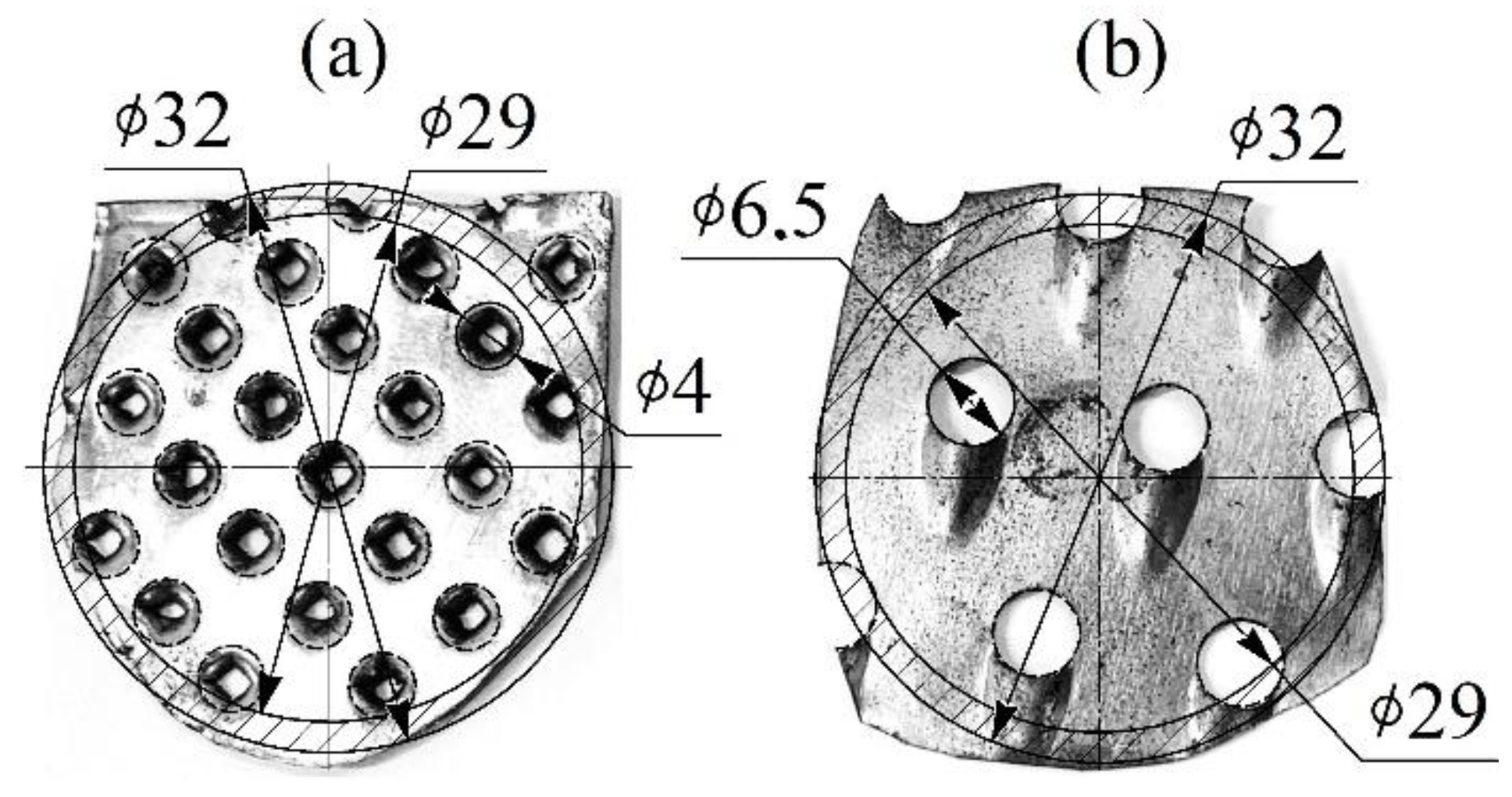
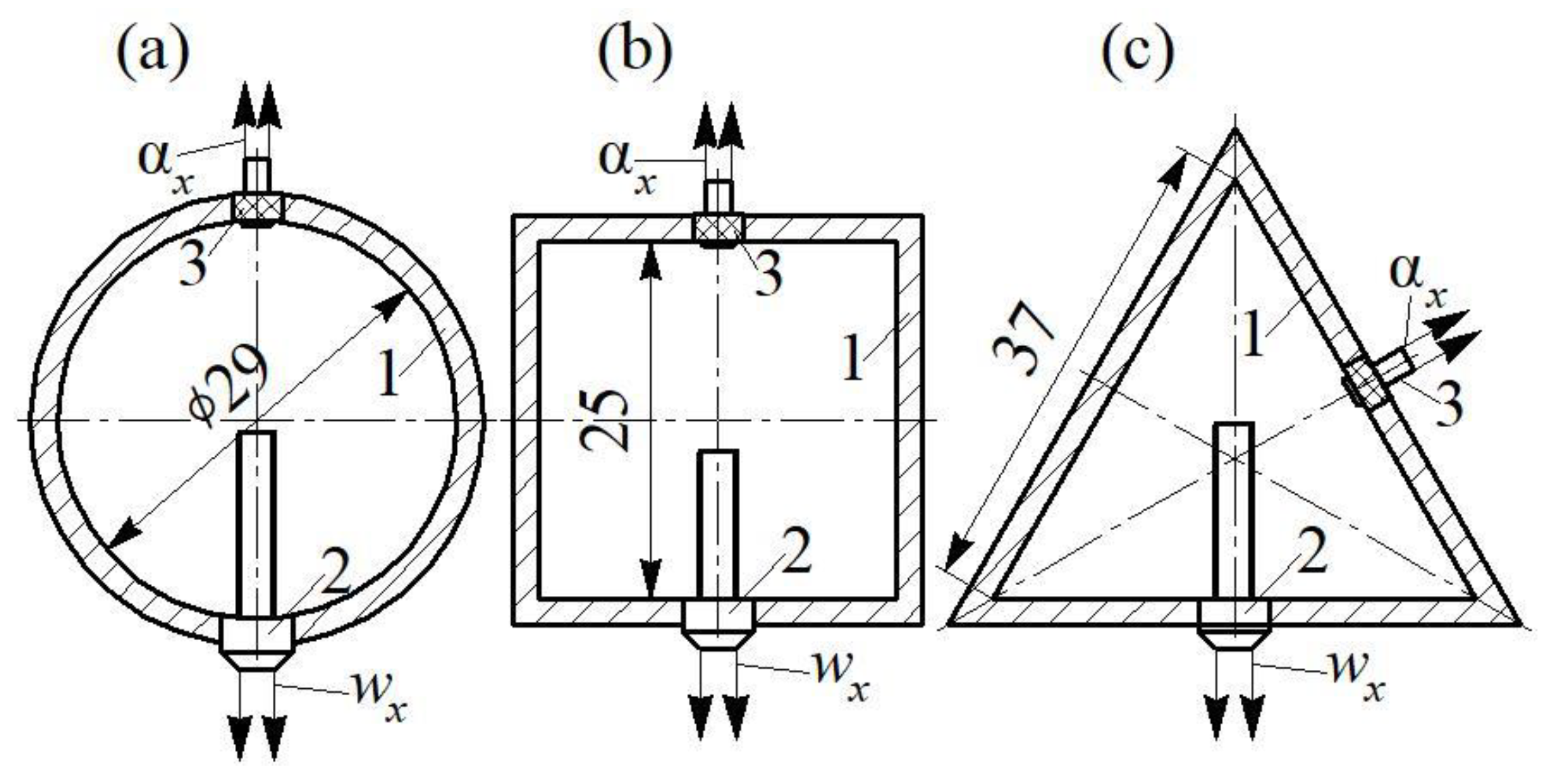
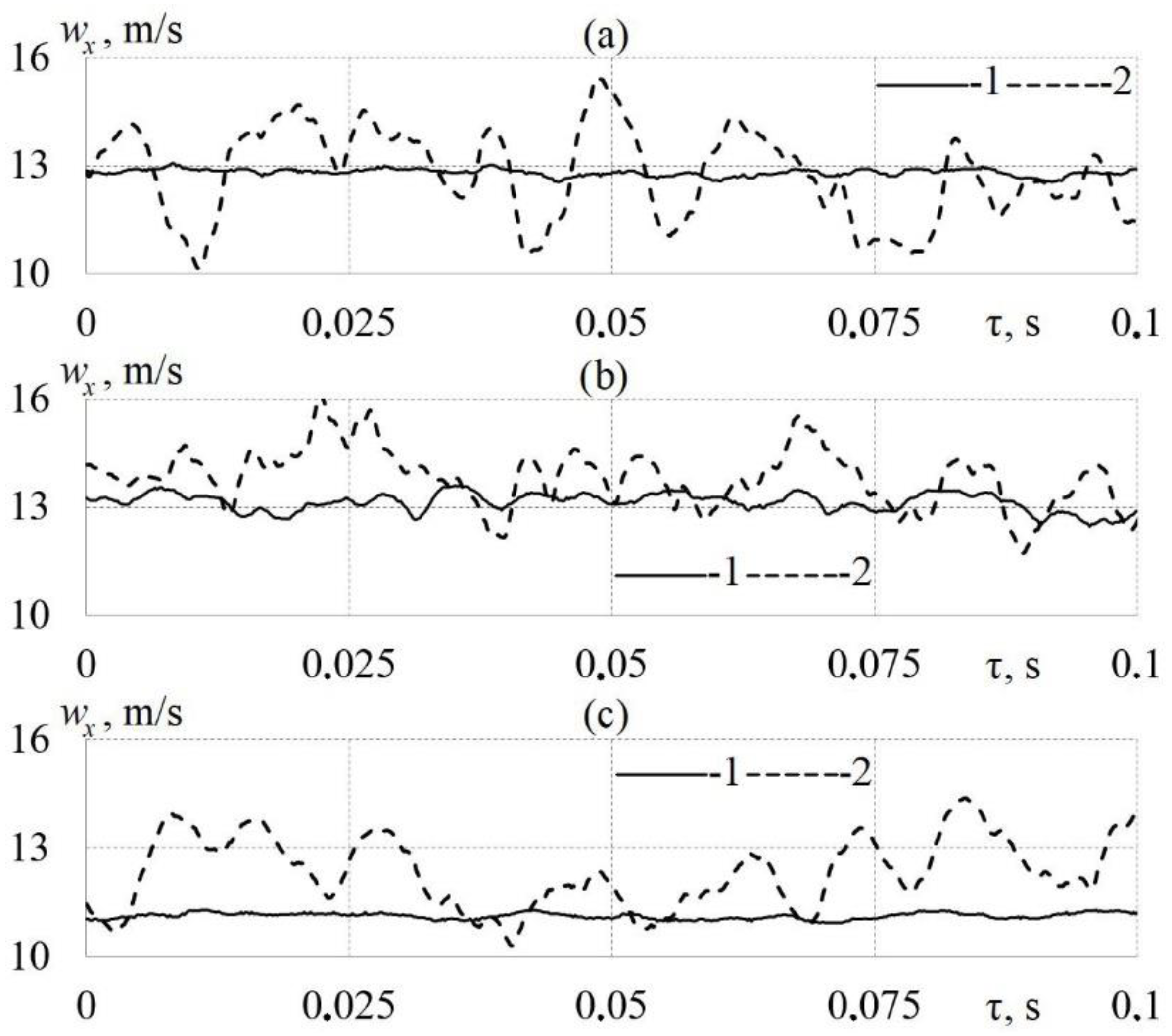




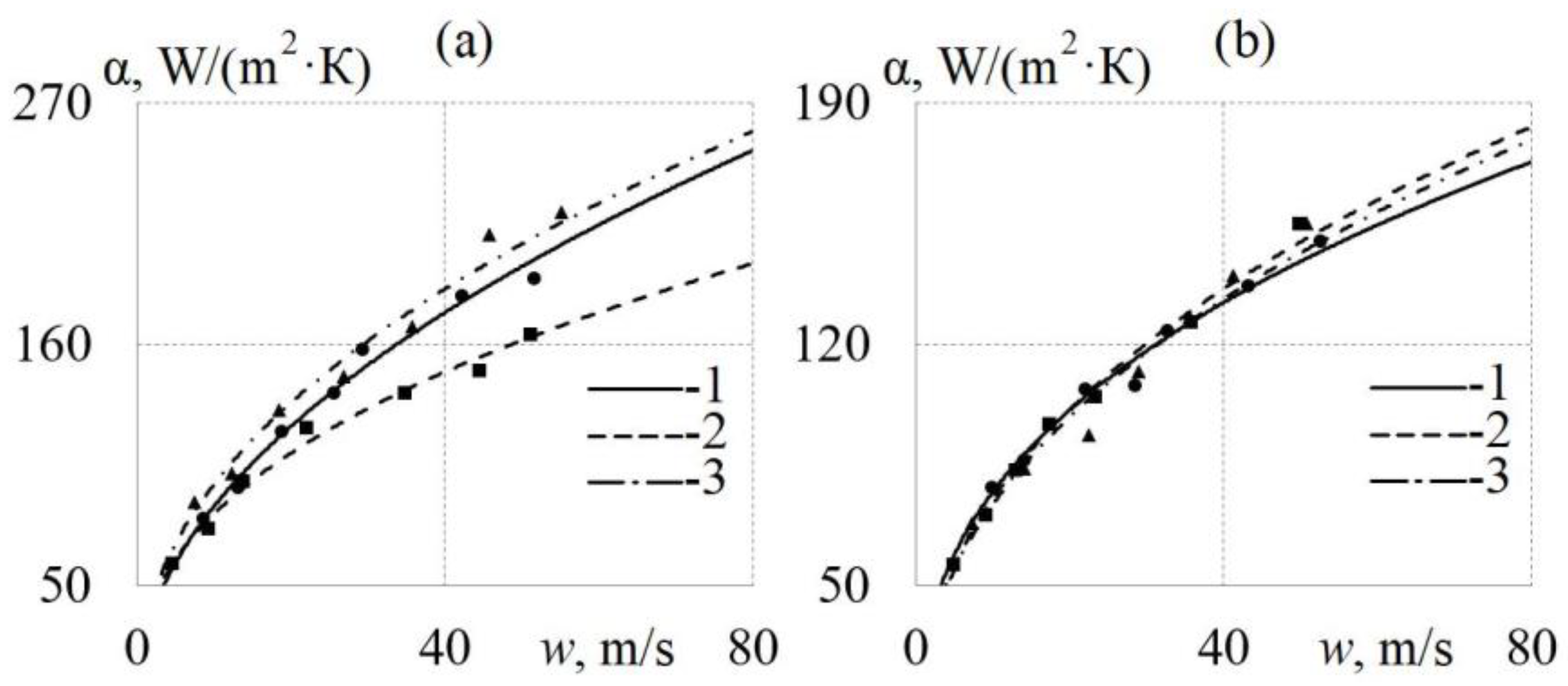

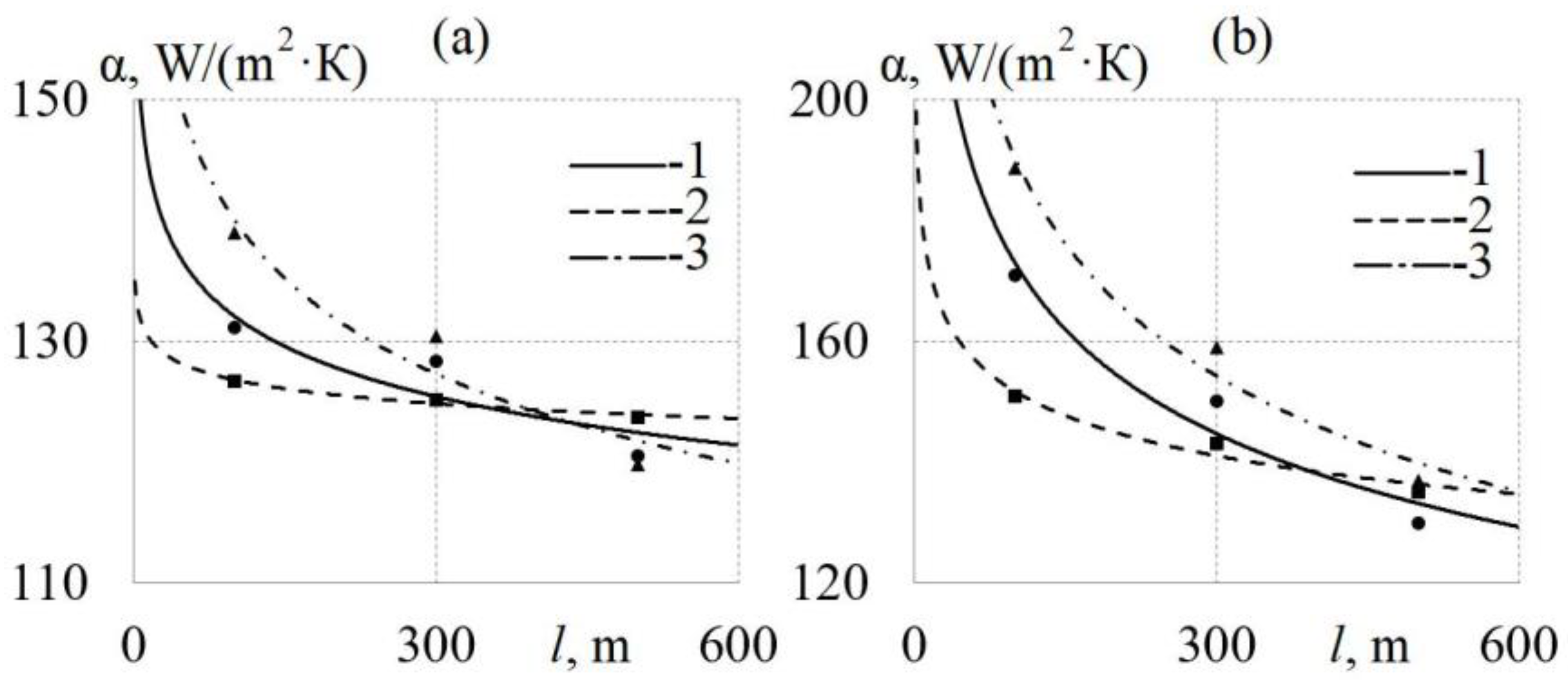
Publisher’s Note: MDPI stays neutral with regard to jurisdictional claims in published maps and institutional affiliations. |
© 2022 by the authors. Licensee MDPI, Basel, Switzerland. This article is an open access article distributed under the terms and conditions of the Creative Commons Attribution (CC BY) license (https://creativecommons.org/licenses/by/4.0/).
Share and Cite
Plotnikov, L.; Grigoriev, N.; Osipov, L.; Slednev, V.; Shurupov, V. Stationary Gas Dynamics and Heat Transfer of Turbulent Flows in Straight Pipes at Different Turbulence Intensity. Energies 2022, 15, 7250. https://doi.org/10.3390/en15197250
Plotnikov L, Grigoriev N, Osipov L, Slednev V, Shurupov V. Stationary Gas Dynamics and Heat Transfer of Turbulent Flows in Straight Pipes at Different Turbulence Intensity. Energies. 2022; 15(19):7250. https://doi.org/10.3390/en15197250
Chicago/Turabian StylePlotnikov, Leonid, Nikita Grigoriev, Leonid Osipov, Vladimir Slednev, and Vladislav Shurupov. 2022. "Stationary Gas Dynamics and Heat Transfer of Turbulent Flows in Straight Pipes at Different Turbulence Intensity" Energies 15, no. 19: 7250. https://doi.org/10.3390/en15197250
APA StylePlotnikov, L., Grigoriev, N., Osipov, L., Slednev, V., & Shurupov, V. (2022). Stationary Gas Dynamics and Heat Transfer of Turbulent Flows in Straight Pipes at Different Turbulence Intensity. Energies, 15(19), 7250. https://doi.org/10.3390/en15197250







